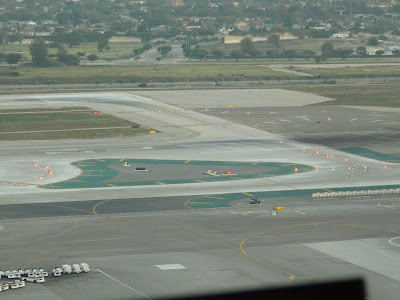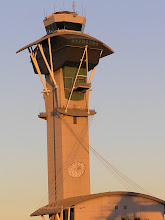Part 3
LAX has several systems in place to prevent runway incursions. Some are for the pilots, another for the controllers.
For the pilots, we have illuminated runway hold lines installed in the pavement of the taxiways. These are always on, independent of the runway lights, and are bright enough to be visible even during the day. At each runway intersection, there is a line of alternating flashing white lights that face away from the runway to mark the hold line. Their sole purpose is to highlight the runway hold line for aircraft approaching the runway; they are not visible to the pilot on the runway.
For the pilots, we have illuminated runway hold lines installed in the pavement of the taxiways. These are always on, independent of the runway lights, and are bright enough to be visible even during the day. At each runway intersection, there is a line of alternating flashing white lights that face away from the runway to mark the hold line. Their sole purpose is to highlight the runway hold line for aircraft approaching the runway; they are not visible to the pilot on the runway.
These two shots both show the runway hold line lights. In the top shot, they're the line of white lights at the top/left, marking the hold line at H-6 and runway 25 left. In the lower shot, you can see the runway hold line for runway 25 right/seven left running across the top of the shot, with the associated lights. If you look closely, you can see the alternating lights in between the bright lights. These lights are always on, day and night.
The other warning system we have for the pilots is also a series of lights installed in the pavement, and likewise requires no input from the controllers. Known as Runway Status Lights, these lights only illuminate when the runway is occupied with an arriving or departing aircraft. I first saw these in action at DFW - the first airport to have them installed. LAX was the second, although not all intersections are covered. The system has runway entrance lights on taxiways that intersect the runway which come on when the system detects an aircraft on short final to land or rolling for departure on that runway. The lights go out as the arriving/departing aircraft passes through the intersection. Unlike the runway hold line lights, the runway status lights are red and run along the taxiway centerline:

 In these shots of the east end of the north complex, you can see the white runway hold line lights running across taxiway V at the edges of both runways. In addition, the red runway status lights are illuminated on V and E-8, indicating that an aircraft is about to land on runway 24 left (actually 6 right in this particular case, but the system is bi-directional) and it is not safe for an aircraft to enter the runway at these intersections. Unfortunately, my camera doesn't do a good job of photographing lights and so the color is pretty washed out - in real life the runway status lights are a very intense red. A close inspection of the second photo, which is a close up of our recently-relocated taxiway E-8, will reveal a string of green lights along the taxiway centerline as well as the red runway status lights. These green lights simply mark the taxiway centerline, and are a standard fixture at many airports, just as blue lights mark the taxiway edges and white lights mark the runway edges. The taxiway and runway edge and centerline lighting is controlled from the control tower, but the hold line lights are not. The runway status lights are autonomous, although the tower can shut the system down if it's malfunctioning.
In these shots of the east end of the north complex, you can see the white runway hold line lights running across taxiway V at the edges of both runways. In addition, the red runway status lights are illuminated on V and E-8, indicating that an aircraft is about to land on runway 24 left (actually 6 right in this particular case, but the system is bi-directional) and it is not safe for an aircraft to enter the runway at these intersections. Unfortunately, my camera doesn't do a good job of photographing lights and so the color is pretty washed out - in real life the runway status lights are a very intense red. A close inspection of the second photo, which is a close up of our recently-relocated taxiway E-8, will reveal a string of green lights along the taxiway centerline as well as the red runway status lights. These green lights simply mark the taxiway centerline, and are a standard fixture at many airports, just as blue lights mark the taxiway edges and white lights mark the runway edges. The taxiway and runway edge and centerline lighting is controlled from the control tower, but the hold line lights are not. The runway status lights are autonomous, although the tower can shut the system down if it's malfunctioning.As I mentioned earlier however, not all of our runway/taxiway intersections are covered by the runway status light system. Taxiway M, where this incursion took place, is not one of the protected intersections. The diagram below shows which intersections at LAX currently are covered by RWSL:

As you can see in this graphic borrowed from the Sensis site, not all of our intersections have RWSL coverage. In addition, one of our runways is fitted with another facet of the system: Lights that warn an aircraft in postion on (or on short final for) runway 24 left that the runway is not safe for departure (or landing).In addition to the lighting systems designed to aid the pilots in identifying runway hold lines and unsafe runway intersections, the controllers have the Airport Surface Detection Equipment, or ASDE, to help us keep track of aircraft and vehicles moving on the ground. Built into the ASDE is a safety logic system that projects possible runway collision hazards and warns the controllers. When it detects an arriving or departing aircraft, the system will illuminate the runway hold lines on the tower ground display. These lines will drop at each intersection as the aircraft passes. If the safety logic projects a possible conflict, the affected targets are highlighted in red boxes on the display and an audio 'runway occupied' or 'go around' alert message is heard. Part of our regular checklist is checking the alert message volume level, and trust me when I tell you that no one in the cab can possibly miss it when the thing goes off. In addition, anytime it does go off the supervisor on duty has to investigate the situation and make an entry in the daily log. The system also has replay capability, allowing for investigations afterwards. Unfortunately, I do not have permission to show you our equipment or displays, so the best I can do is give you some links to some sites where you can read more:
Sensis
Wikipedia
Sensis
Wikipedia
This is a copy of the image on the Wikipedia entry on ASDE-X, showing part of Atlanta Hartsfield airport (KATL) tower's display of the south side of the airport. Runways are black, taxiways are gray. You can see the green runway hold lines lit up at each intersection on the lower runway (27 left), where the arriving aircraft (DAL723) is just over the runway threshhold. The longer runway (27 right) has a departure about mid-field, and the hold lines ahead of it are still up, while the ones behind it have gone out. You can see several previous arrivals waiting to cross, the next departure in position, and several more departures in line on the taxiway. The yellow icon for the first waiting aircraft denotes that aircraft to be a wake turbulence airplane, either a B757 or a heavy.



No comments:
Post a Comment